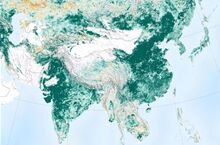地球更绿了!美国航天局:中国和印度贡献最大
12日,美国国家航空航天局(NASA)发推文表示,与20年前相比,地球越来越绿了。
环保人士的好消息:与20年前相比,世界越来越绿了。美国航天局地球卫星数据显示,中国和印度的植树造林和农业等活动主导了地球变绿的过程。
India and China are leading the global greening effort, a latest NASA study said Monday, observing that the world is a greener place than it was 20 years ago.
美国航天局2月11日发布最新研究称,全世界的绿化程度比20年前更高,而在这20年间,中国和印度始终都是全球绿化努力的领导者。

The study published in the journal 'Nature Sustainability' said that recent satellite data reveals a greening pattern that is strikingly prominent in China and India and overlaps with croplands world-wide.
这份发表在《自然·可持续发展》杂志上的最新研究报告称,最近的卫星数据显示,中国和印度境内的绿化规模非常醒目,而这些绿化地区与世界各地的农田区域重叠。
overlap [əʊvə'læp]:vi.部分重叠
Data from NASA Earth satellites shows that human activity in China and India dominate this greening of the planet, thanks to tree planting & agriculture.
来自NASA地球卫星的数据显示,中国和印度的植树造林和农业等活动主导了地球变绿的过程。
The effect comes mostly from ambitious tree-planting programs in China and intensive agriculture in both countries.
今天的地球之所以能变得“更绿色”,主要是受到中国雄心勃勃的植树计划和中印两国集约型农业的影响。
"China and India account for one-third of the greening," said lead author Chi Chen of Boston University.
该研究报告的第一作者、波士顿大学的陈驰(音)说:“中国和印度在全球绿化面积中占比达三分之一。”
"That is a surprising finding, considering the general notion of land degradation in populous countries from overexploitation," added Chen.
“这是一个出人意料的发现。因为人们普遍认为,人口密集国家的过度开发会导致土壤退化。”
而2月11日发表在《自然》(Nature)杂志的文章也证实了这一观点。
通过土地使用管理,中国和印度在地球绿化过程中领跑 文章称,中国和印度境内大量植树并且实施农业集约化,地球比20年前更加绿色了。过去20年里地球增加的绿化面积,相当于亚马逊热带雨林的覆盖面积。
其中,中国贡献突出。
China alone accounts for 25 percent of the global net increase in leaf area with only 6.6 percent of global vegetated area.
中国仅占全球植被面积的6.6%,但全球植被叶面积净增长的25%都来自中国。
与印度主要来自耕地的绿化不同,中国的绿化来自森林和耕地两个方面。
The greening in China is from forests (42 percent) and croplands (32 percent), but in India, it is mostly from croplands (82 percent) with minor contribution from forests (4.4 percent).
其中,中国的绿化面积主要来自森林(42%)和耕地(32%),而印度主要来自耕地(82%),森林只占4.4%。
China's outsized contribution to the global greening trend comes in large part from its programs to conserve and expand forests with the goal of mitigating land degradation, air pollution, and climate change.
中国对全球绿化的巨大贡献在很大程度上来自其保护和扩大森林计划,该项目旨在缓解土地退化、空气污染和气候变化。
"When the greening of the Earth was first observed, we thought it was due to a warmer, wetter climate and fertilization from the added carbon dioxide in the atmosphere. Now with the MODIS data, we see that humans are also contributing," said Rama Nemani, research scientist at NASA's Ames Research Center and co-author of the study.
研究报告的作者之一、美国航天局艾姆斯研究中心的科学家拉马·内马尼说:“我们最初观察到地球绿化时,我们认为这是由于气候变暖、变潮湿,且由于大气中二氧化碳含量增加使土地更加肥沃。现在有了中分辨率遥感卫星的数据,我们发现人类也起着很大作用。”
"Once people realize there is a problem, they tend to fix it. In the 1970s and 80s in India and China, the situation around vegetation loss was not good. In the 1990s, people realized it, and today things have improved. Humans are incredibly resilient. That's what we see in the satellite data," added Nemani.
他补充说:“一旦人们意识到有问题,他们往往就会去解决。在上世纪七八十年代的印度和中国,各地植被流失的情况严重。上世纪90年代,人们认识到了这一点,如今情况已经有所改善。人类的适应力令人难以置信。这就是我们在卫星数据中看到的情况。”
NASA网站则详细报道了中国和印度在耕种方面的经验:
Land area used to grow crops is comparable in China and India – more than 770,000 square miles – and has not changed much since the early 2000s. Yet these regions have greatly increased both their annual total green leaf area and their food production.
中国和印度用于种植农作物的土地面积相当,自本世纪初起一直均占77多万平方英里。然而,这些地区的年总叶面积和粮食产量都大大增加了。
This was achieved through multiple cropping practices, where a field is replanted to produce another harvest several times a year. Production of grains, vegetables, fruits and more have increased by about 35-40% since 2000 to feed their large populations.
这是通过复种轮作实现的,即每年多次重新种植土地获得多次收获。自2000年以来,粮食、蔬菜、水果等的产量增加了约35-40%,养活了庞大的人口。
看到这个好消息,全球网友都在为中国和印度点赞:
你为地球绿化,做出贡献了吗?